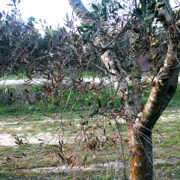Exploiting pathogen confusion strategy to achieve Xylella fastidiosa biocontrol
Authors: G. D’Attoma, M. Saponari, M. Morelli, A. Giampetruzzi, V.N. Savino, D. Boscia, P. Saldarelli
Type of contribution: Conference Abstract | Poster Presentation
Conference: 22th Congress of the Italian Society of Plant Pathology, 19-22 September 2016, Roma (Italy)
Keywords: Xylella fastidiosa, DSF, Quorum sensing
Corresponding author: G. D’Attoma (CNR-IPSP)
Abstract
The recent findings of the plant pathogenic bacterium Xylella fastidiosa (Xf), infecting several plant species in Italy and France, raised major concerns for its potential impact on the EU and Mediterranean agriculture. In the current EU outbreaks, olive is the predominantly affected crop, in which the bacterium has been consistently associated with a new severe syndrome, denoted “Olive Quick Decline”. So far, no effective treatments are available to cure infected plants. However, several approaches have been explored, mainly in grapevine and citrus, to reduce bacterial movement and multiplication or directly targeting Xf-cells for lysis.
Current knowledge shows that the virulence of the pathogen relies on a fine balance between more motile bacterial forms, able to move and proliferate within xylem vessels, and sticky cells forming a biofilm, which are responsible for vessels blockage and insect acquisition. This different behavior is regulated in a cell density-dependent manner by a diffusible signaling factor (DSF), produced by rpfF-gene, that initiates a transduction cascade resulting in up- or down-regulation of several genes.
The aim of our investigation is to explore “pathogen confusion” strategy, by altering DSF level in planta, for reducing the impact of Xf-infections in olives. To this end, a plant viral-based vector, harboring the rpfF-gene, has been engineered to induce transient DSF production. Experiments will verify if, upon DSF accumulation, the bacterium will be less motile and more adhesive to the surface of xylem vessels, thus showing a decreased virulence in infected plants.








